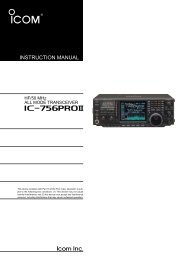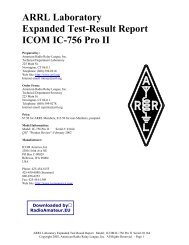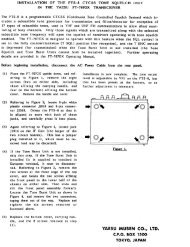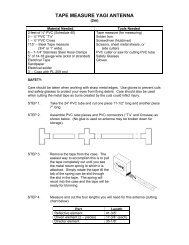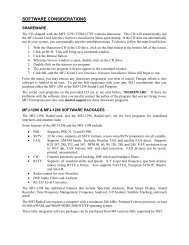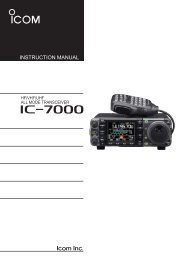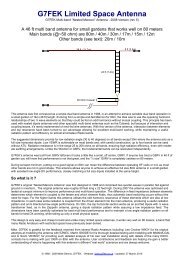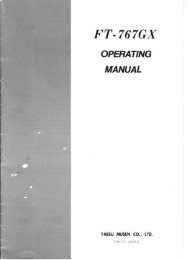Data structure for the ICOM IC-R2 Scanner - OoCities
Data structure for the ICOM IC-R2 Scanner - OoCities
Data structure for the ICOM IC-R2 Scanner - OoCities
- No tags were found...
You also want an ePaper? Increase the reach of your titles
YUMPU automatically turns print PDFs into web optimized ePapers that Google loves.
<strong>Data</strong> RepresentationsIn this document, data is represented in a variety of ways:•= Characters are represented using <strong>the</strong> ASCII and ANSI character sets.•= Numbers are represented in hexadecimal, ASCII representedhexadecimal, or binary.The ASCII Character SetThe ASCII table describes <strong>the</strong> American Standard Code <strong>for</strong> In<strong>for</strong>mationInterchange, <strong>the</strong> basis of character sets used in most present-day computers.US-ASCII uses only <strong>the</strong> lower seven bits (characters 0 to 127) to convey somecontrol codes, space, numbers, most basic punctuation, and unaccented lettersa-z and A-Z. Appendix B shows <strong>the</strong> ASCII Character set.The ANSI Character SetThe ANSI character set (developed by <strong>the</strong> American National Standards Institute- ANSI), is a standard extension of <strong>the</strong> ASCII character set. The table atAppendix C shows characters 128-255 of <strong>the</strong> ANSI character set.Hexadecimal Numbers.Hexadecimal (Or "hex") numbers count in base 16 (decimal numbers count inbase 10). Hexadecimal numbers are represented using <strong>the</strong> digits 0-9, with <strong>the</strong>irusual meaning, plus <strong>the</strong> letters A-F (or a-f) to represent hexadecimal digits withvalues of (decimal) 10 to 15. The right-most digit counts ones, <strong>the</strong> next countsmultiples of 16, <strong>the</strong>n 16^2 = 256, etc.There are many conventions <strong>for</strong> distinguishing hexadecimal numbers fromdecimal or o<strong>the</strong>r bases in programs. In <strong>the</strong> C programming language <strong>for</strong>example, <strong>the</strong> prefix "0x" is used, e.g. 0x694A11. In Visual Basic <strong>the</strong> prefix "&H"is used, e.g. &H3F6. In this document <strong>the</strong> prefix "$" is used, e.g. $3AF.One of <strong>the</strong> advantages of using hexadecimal numbers is that two charactersrepresent one byte of data (an 8 bit number). For example 159 (decimal) isrepresented as $9F.In this document, numbers are usually represented in a hexadecimal <strong>for</strong>mat:Hexadecimal $0 $1 $2 $3 $4 $5 $6 $7 $8 $9 $A $B $C $D $E $F $10numberDecimalequivalent0 1 2 3 4 5 6 7 8 9 10 11 12 13 14 15 164



